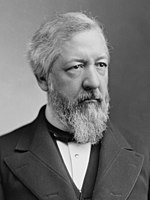1884 United States presidential election
| |||||||||||||||||||||||||||||
401 members of the Electoral College 201 electoral votes needed to win | |||||||||||||||||||||||||||||
|---|---|---|---|---|---|---|---|---|---|---|---|---|---|---|---|---|---|---|---|---|---|---|---|---|---|---|---|---|---|
| Turnout | 77.5%[1] | ||||||||||||||||||||||||||||
| |||||||||||||||||||||||||||||
 Presidential election results map. Blue denotes those won by Cleveland/Hendricks, red denotes states won by Blaine/Logan. Numbers indicate the number of electoral votes allotted to each state. | |||||||||||||||||||||||||||||
| |||||||||||||||||||||||||||||
The 1884 United States presidential election was the 25th election in the history of the United States. It occurred on November 4, 1884. This election was between Governor Grover Cleveland of New York and former Secretary of State James G. Blaine of Maine. Cleveland won the election with 219 electoral votes. Blaine got only 182 electoral votes.
Candidates[change | change source]
Republican Party[change | change source]
Presidential[change | change source]
- James G. Blaine, Former Secretary of State from Maine (1881; 1889-1892) (Nominee)
- Chester A. Arthur, 21st President of the United States from New York (1881-1885)
- George F. Edmunds, President Pro Tempore of the United States Senate(1883-1885) and Senator from Vermont (1866-1891)
- John A. Logan, Senator from Illinois (1871-1877; 1879-1886) (Vice-Presidential Nominee)
- John Sherman, Senator of Ohio (1861-1877; 1881-1897)
- Joseph R. Hawley, Senator of Connecticut (1881-1905)
Declined to contest[change | change source]
- Robert Todd Lincoln, Secretary of War from Illinois (1881-1885) (Son of Abraham Lincoln)
- William T. Sherman, former Commanding General of the United States Army from Ohio (1869-1883)
- Philip Sheridan, Lieutenant General of the United States Army from New York (1869-1888)
Vice-Presidential[change | change source]
- John A. Logan, Senator from Illinois (1871-1877; 1879-1886) (Vice-Presidential Nominee)
- Walter Q. Gresham, Postmaster General from Indiana (1893-1894)
- Joseph B. Foraker, Unsuccessful Republican Candidate in the 1883 Ohio Gubernational Election (Later served as Governor of Ohio from 1886-1890 and as Senator of Ohio from 1897-1909)
Democratic Party[change | change source]
Presidential[change | change source]
- Grover Cleveland, Governor of New York (1883-1885) (Nominee)
- Thomas F. Bayard, Senator of Delaware (1863-1885)
- Thomas A. Hendricks, Former Governor of Indiana (1873-1877) and 1876 Democratic Vice-Presidential Nominee (Vice-Presidential Nominee)
- Allen G. Thurman, Former Governor of Ohio (1869-1881)
- Samuel J. Randall, Former Speaker of the House (1876-1881) and Congressman from Pennsylvania (1863-1875; 1875-1890)
- Joseph E. McDonald, Former Senator of Indiana (1875-1881)
- John G. Carlisle, Speaker of the House (1883-1889) and Congressman from Kentucky (1877-1890)
- George Hoadly, Governor of Ohio (1884-1886)
Vice-Presidential[change | change source]
- Thomas A. Hendricks, Former Governor of Indiana (1873-1877) (Vice-Presidential Nominee) (1876 Democratic Vice-Presidential Nominee)
Withdrawn candidates[change | change source]
- John C. Black, Brevet Brigadier General from Illinois (1866-1915)
- George W. Click, Governor of Kansas (1883-1885)
- Joseph E. McDonald, Former Senator of Indiana (1875-1881)
- William Rosecrans, Major General and Congressman from California (1881-1885)
References[change | change source]
- ↑ "Voter Turnout in Presidential Elections". The American Presidency Project. UC Santa Barbara.


